Charles E W Bean, Diaries, AWM38 3DRL 606/274/1 - 1918 - 1941 - Part 17
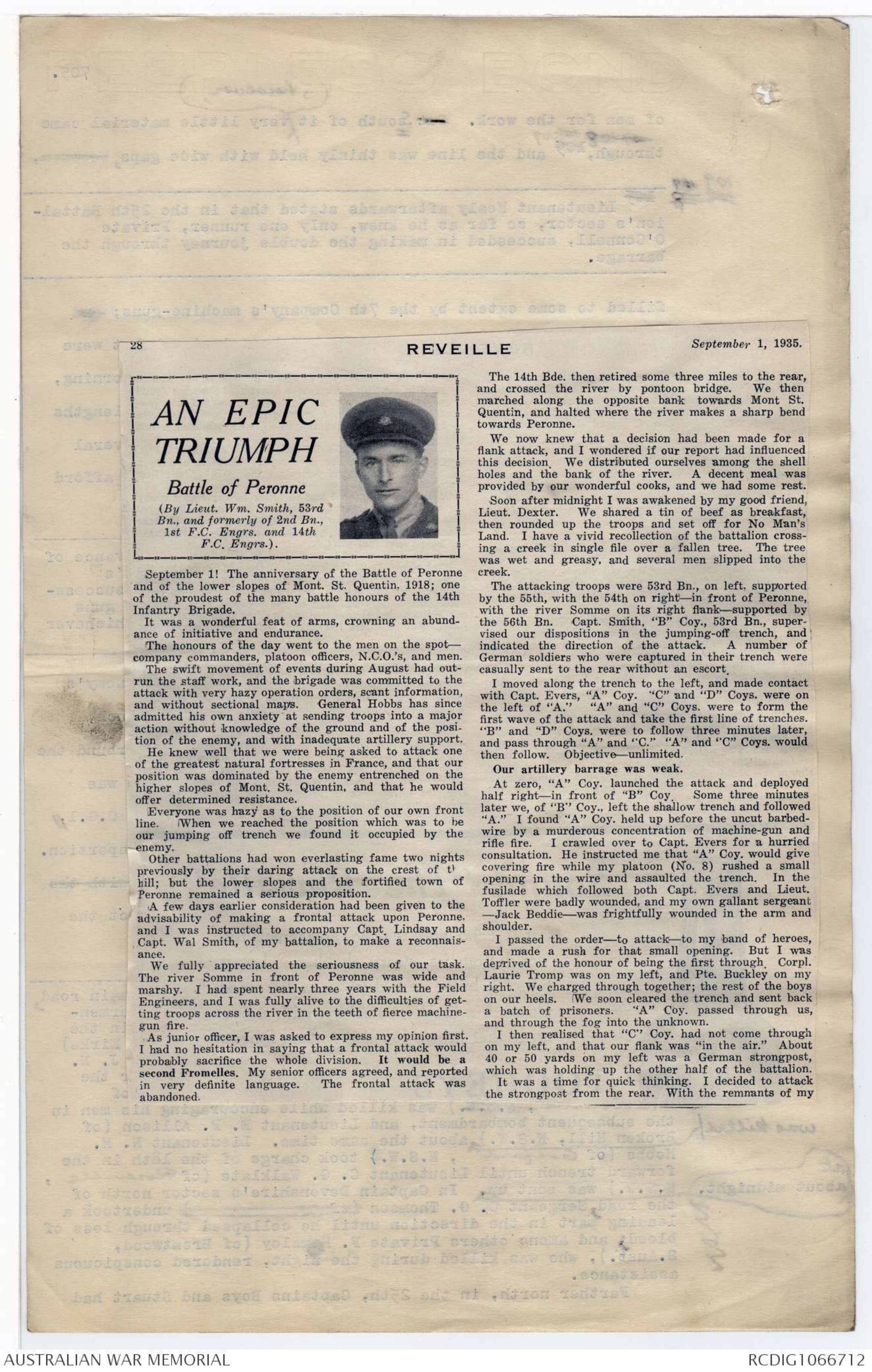
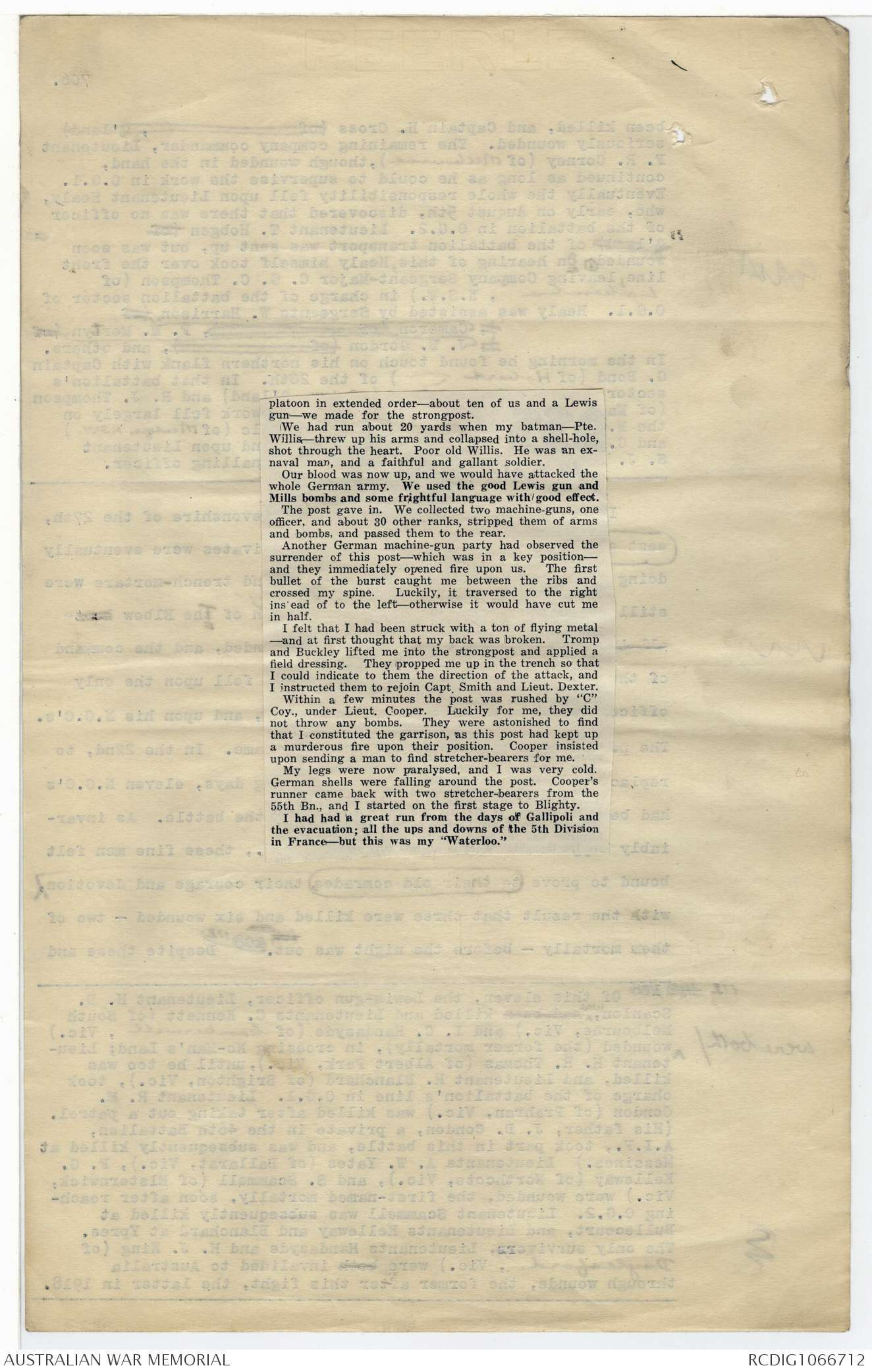
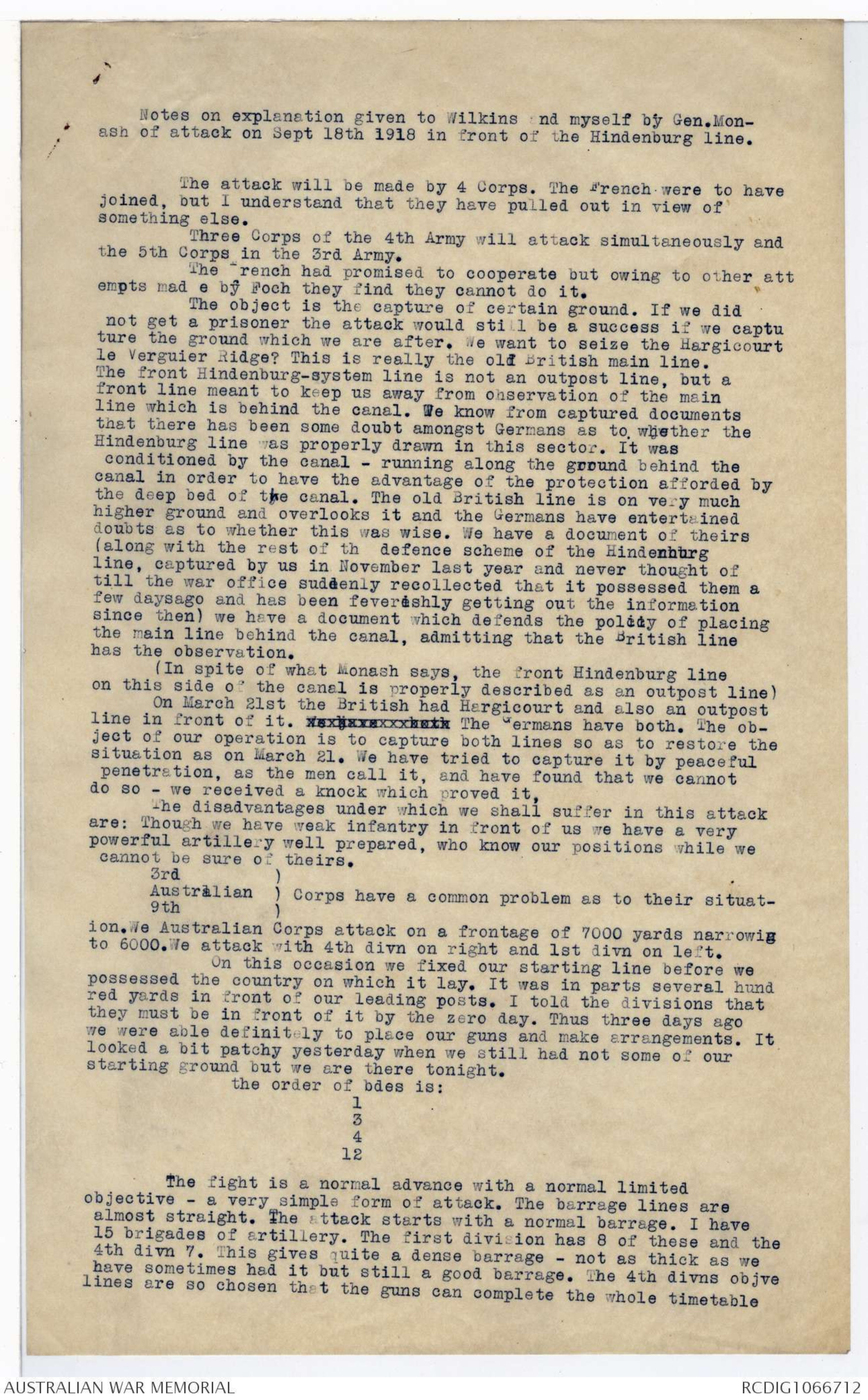

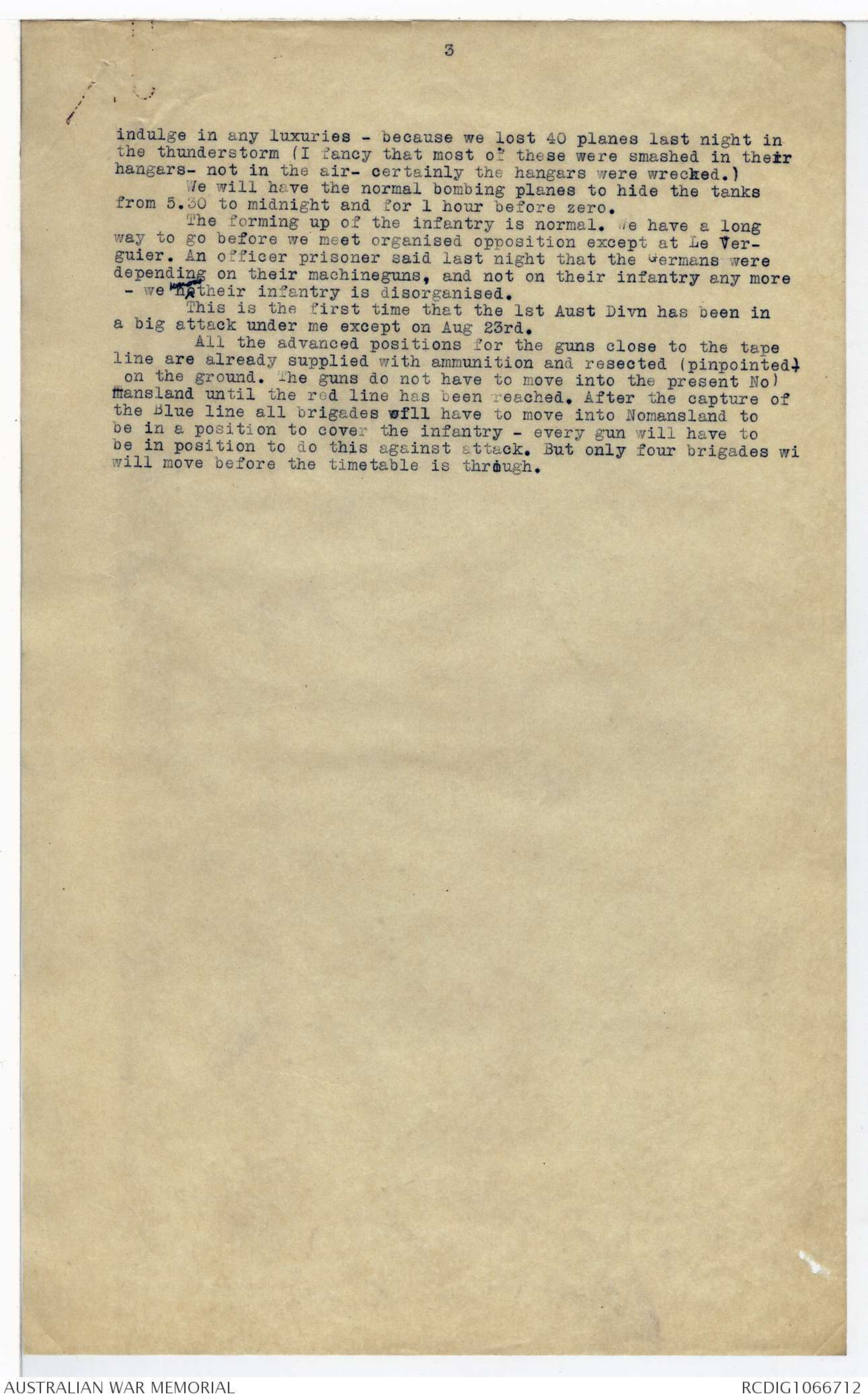
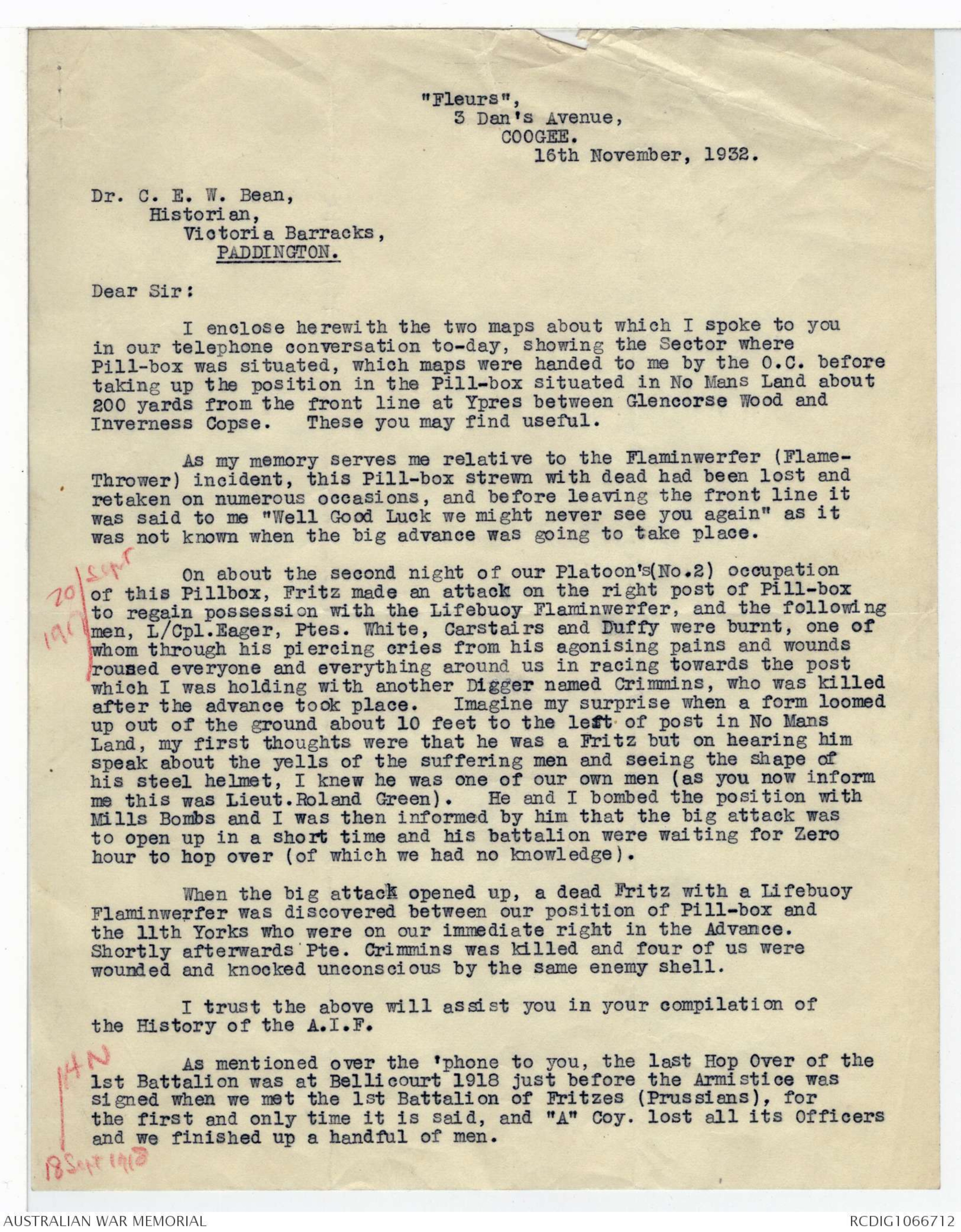
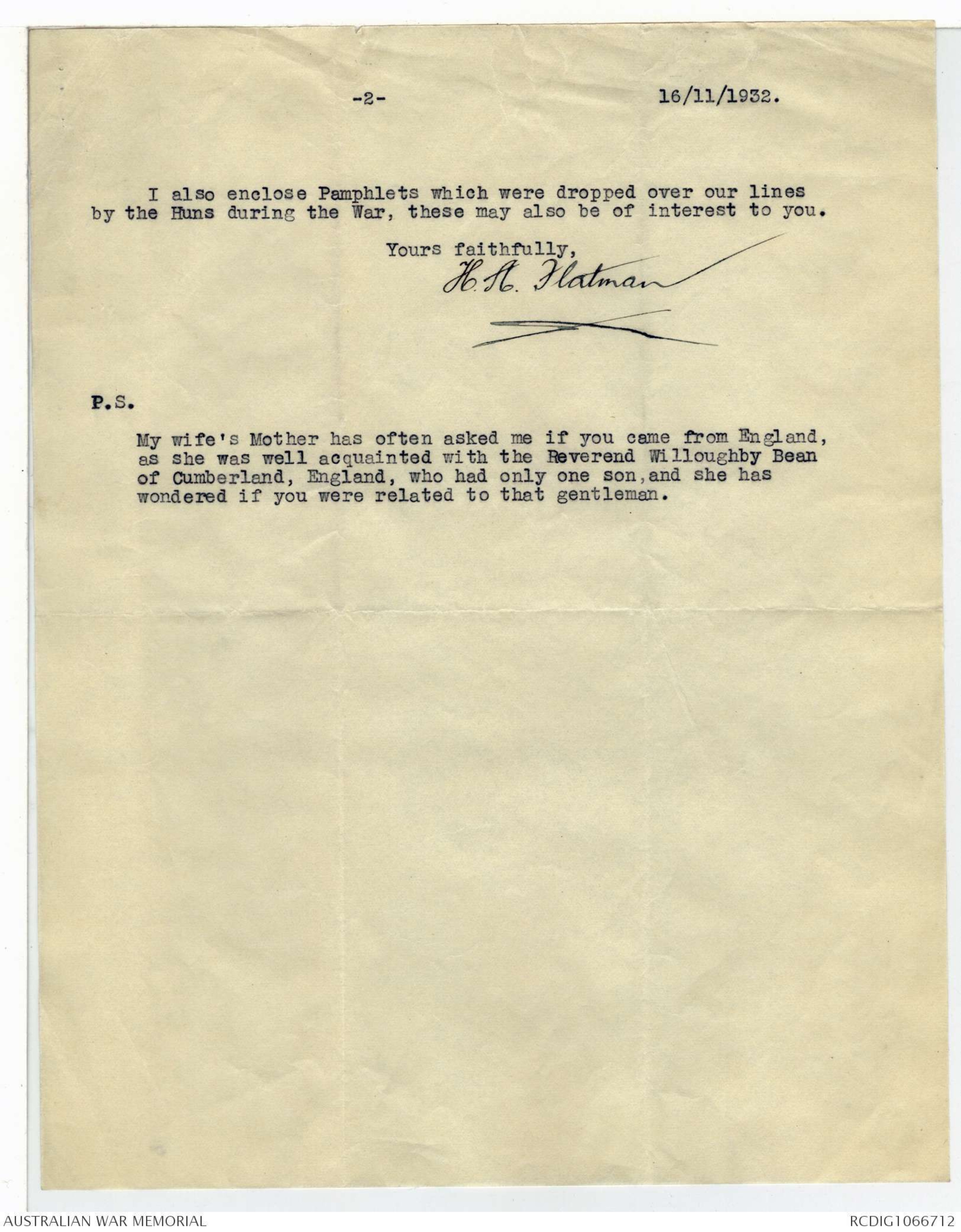
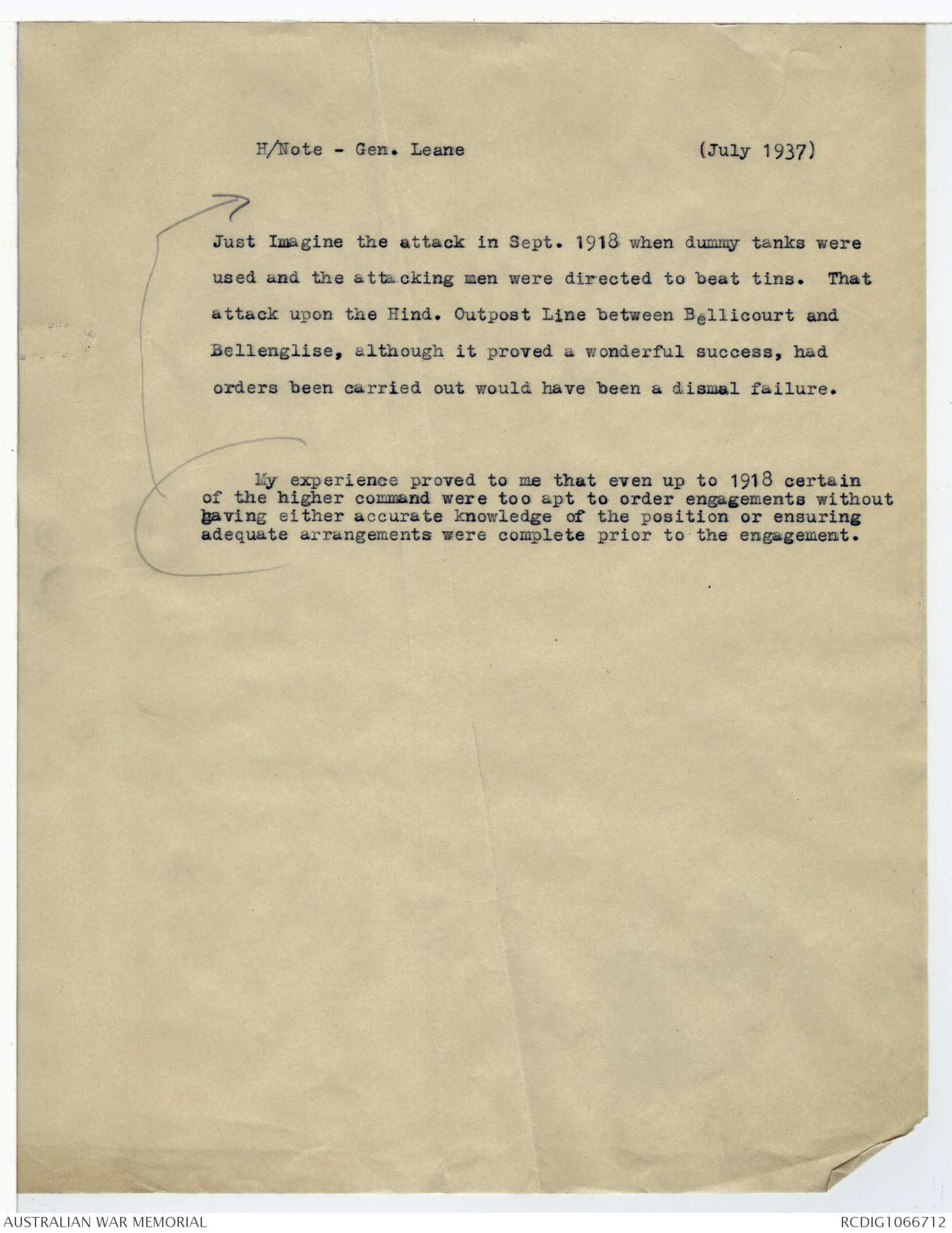
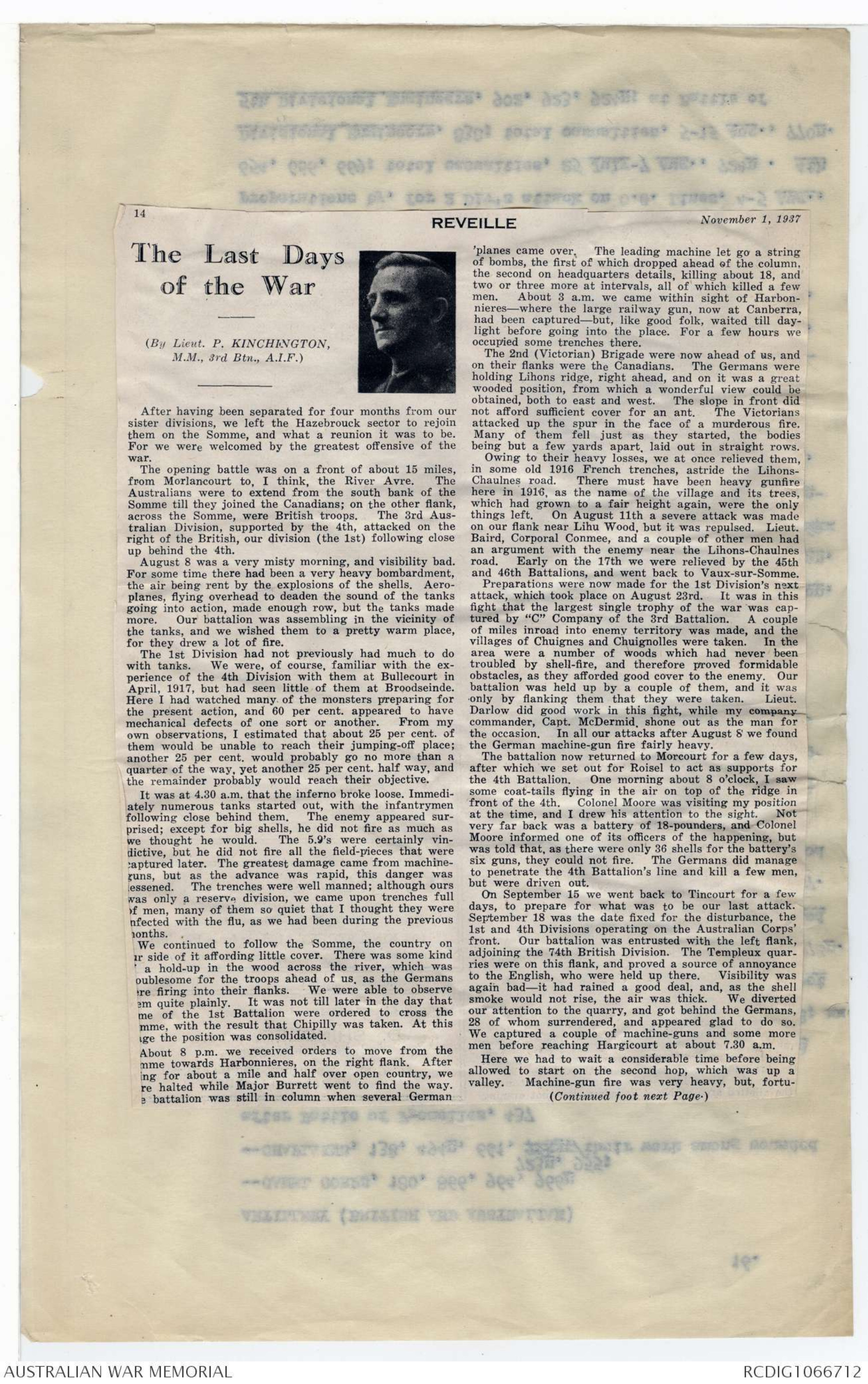
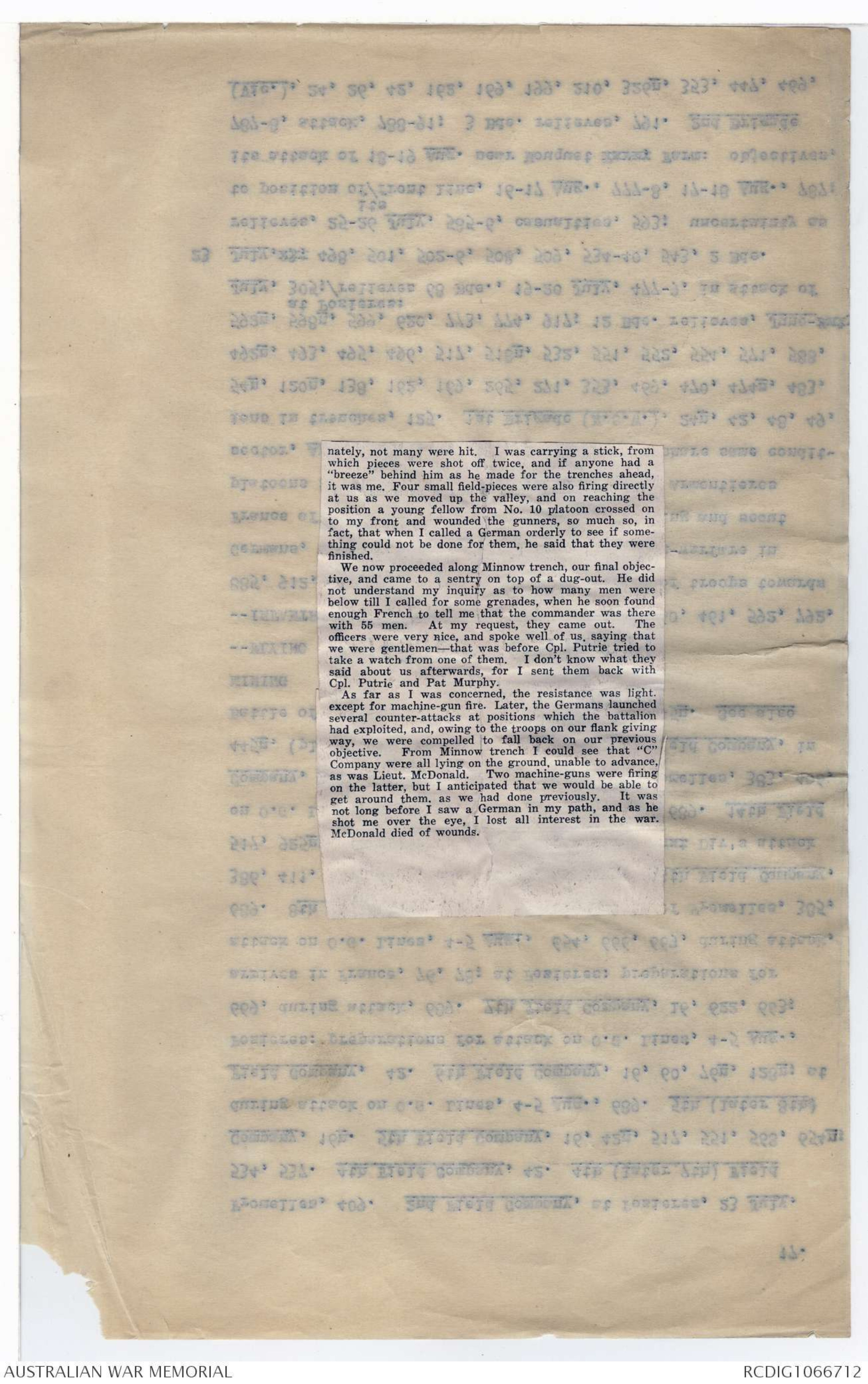
28
REVEILLE September 1, 1935.
AN EPIC TRIUMPH
Battle of Peronne
(By Lieut. Wm. Smith, 53rd
Bn., and formerly of 2nd Bn.,
1st F.C. Engrs. and l4th
F.C.Engrs.).
September 1! The anniversary of the Battle of Peronne
and of the lower slopes of Mont. St. Quentin, 1918; one
of the proudest of the many battle honours of the 14th
Infantry Brigade.
It was a wonderful feat of arms, crowning an abundance
of initiative and endurance.
The honours of the day went to the men on the spot—
company commanders, platoon officers, N.C.O.'s, and men.
The swift movement of events during August had outrun
the staff work, and the brigade was committed to the
attack with very hazy operation orders, scant information,
and without sectional maps. General Hobbs has since
admitted his own anxiety at sending troops into a major
action without knowledge of the ground and of the position
of the enemy, and with inadequate artillery support.
He knew well that we were being asked to attack one
of the greatest natural fortresses in France, and that our
position was dominated by the enemy entrenched on the
higher slopes of Mont. St. Quentin, and that he would
offer determined resistance.
Everyone was hazy as to the position of our own front
line. When we reached the position which was to be
our jumping off trench we found it occupied by the
enemy.
Other battalions had won everlasting fame two nights
previously by their daring attack on the crest of [[the]]
hill; but the lower slopes and the fortified town of
Peronne remained a serious proposition.
A few days earlier consideration had been given to the
advisability of making a frontal attack upon Peronne,
and I was instructed to accompany Capt. Lindsay and
Capt. Wal Smith, of my battalion, to make a reconnaisance.
We fully appreciated the seriousness of our task.
The river Somme in front of Peronne was wide and
marshy. I had spent nearly three years with the Field
Engineers, and I was fully alive to the difficulties of getting
troops across the river in the teeth of fierce machine-gun
fire.
As junior officer, I was asked to express my opinion first.
I had no hesitation in saying that a frontal attack would
probably sacrifice the whole division. It would be a
second Fromelles. My senior officers agreed, and reported
in very definite language. The frontal attack was
abandoned.
The 14th Bde. then retired some three miles to the rear,
and crossed the river by pontoon bridge. We then
marched along the opposite bank towards Mont St.
Quentin, and halted where the river makes a sharp bend
towards Peronne.
We now knew that a decision had been made for a
flank attack, and I wondered if our report had influenced
this decision. We distributed ourselves among the shell
holes and the bank of the river. A decent meal was
provided by our wonderful cooks, and we had some rest.
Soon after midnight I was awakened by my good friend
Lieut. Dexter. We shared a tin of beef as breakfast,
then rounded up the troops and set off for No Man's
Land. I have a vivid recollection of the battalion crossing
a creek in single file over a fallen tree. The tree
was wet and greasy, and several men slipped into the
creek.
The attacking troops were 53rd Bn., on left, supported
by the 55th, with the 54th on right— in front of Peronne,
with the river Somme on its right flank—supported by
the 56th Bn. Capt. Smith, “B" Coy., 53rd Bn., supervised
our dispositions in the jumping-off trench, and
indicated the direction of the attack. A number of
German soldiers who were captured in their trench were
casually sent to the rear without an escort.
I moved along the trench to the left, and made contact
with Capt. Evers, "A” Coy. "C" and "D” Coys. were on
the left of "A." "A" and "C" Coys. were to form the
first wave of the attack and take the first line of trenches.
"B" and "D" Coys. were to follow three minutes later,
and pass through "A” and "C." "A” and "C" Coys. would
then follow. Objective—unlimited.
Our artillery barrage was weak.
At zero, "A" Coy. launched the attack and deployed
half right—in front of "B" Coy. Some three minutes
later we, of "B" Coy., left the shallow trench and followed
"A." I found "A” Coy. held up before the uncut barbed-
wire by a murderous concentration of machine-gun and
rifle fire. I crawled over to Capt. Evers for a hurried
consultation. He instructed me that "A” Coy. would give
covering fire while my platoon (No. 8) rushed a small
opening in the wire and assaulted the trench. In the
fusilade which followed both Capt. Evers and Lieut.
Toffler were badly wounded, and my own gallant sergeant
—Jack Beddie— was frightfully wounded in the arm and
shoulder.
I passed the order—to attack—to my band of heroes,
and made a rush for that small opening. But I was
deprived of the honour of being the first through. Corpl.
Laurie Tromp was on my left, and Pte. Buckley on my
right. We charged through together; the rest of the boys
on our heels. We soon cleared the trench and sent back
a batch of prisoners. "A" Coy. passed through us,
and through the fog into the unknown.
I then realised that "C” Coy. had not come through
on my left, and that our flank was "in the air." About
40 or 50 yards on my left was a German strongpost,
which was holding up the other half of the battalion.
It was a time for quick thinking. I decided to attack
the strongpost from the rear. With the remnants of my
platoon in extended order—about ten of us and a Lewis
gun— we made for the strongpost.
We had run about 20 yards when my batman—Pte.
Willis—threw up his arms and collapsed into a shell-hole,
shot through the heart. Poor old Willis. He was an ex-naval
man, and a faithful and gallant soldier.
Our blood was now up, and we would have attacked the
whole German army. We used the good Lewis gun and
Mills bombs and some frightful language with good effect.
The post gave in. We collected two machine-guns, one
officer, and about 30 other ranks, stripped them of arms
and bombs, and passed them to the rear.
Another German machine-gun party had observed the
surrender of this post—which was in a key position—
and they immediately opened fire upon us. The first
bullet of the burst caught me between the ribs and
crossed my spine. Luckily, it traversed to the right
[[instead]] of to the left— otherwise it would have cut me
in half.
I felt that I had been struck with a ton of flying metal
—and at first thought that my back was broken. Tromp
and Buckley lifted me into the strongpost and applied a
field dressing. They propped me up in the trench so that
I could indicate to them the direction of the attack, and
I instructed them to rejoin Capt. Smith and Lieut. Dexter.
Within a few minutes the post was rushed by "C"
Coy., under Lieut. Cooper. Luckily for me, they did
not throw any bombs. They were astonished to find
that I constituted the garrison, as this post had kept up
a murderous fire upon their position. Cooper insisted
upon sending a man to find stretcher-bearers for me.
My legs were now paralysed, and I was very cold.
German shells were falling around the post. Cooper's
runner came back with two stretcher-bearers from the
55th Bn., and I started on the first stage to Blighty.
I had had a great run from the days of Gallipoli and
the evacuation; all the ups and downs of the 5th Division
in France– but this was my "Waterloo."
Notes on explanation given to Wilkins [[and]] myself by Gen. Monash
of attack on Sept 18th 1918 in front of the Hindenburg line.
The attack will be made by 4 Corps. The French were to have
joined, but I understand that they have pulled out in view of
something else.
Three Corps of the 4th Army will attack simultaneously and
the 5th Corps in the 3rd Army.
The French had promised to cooperate but owing to other attempts
[[made]] by Foch they find they cannot do it.
The object is the capture of certain ground. If we did
not get a prisoner the attack would still be a success if we captu
ture the ground which we are after. We want to seize the Hargicourt
le Verguier Ridge? This is really the old British main line.
The front Hindenburg-system line is not an outpost line, but a
front line meant to keep us away from ohservation of the main
line which is behind the canal. We know from captured documents
that there has been some doubt amongst Germans as to whether the
Hindenburg line was properly drawn in this sector. It was
conditioned by the canal - running along the [[ground]] behind the
canal in order to have the advantage of the protection afforded by
the deep bed of the canal. The old British line is on very much
higher ground and overlooks it and the Germans have entertained
doubts as to whether this was wise. We have a document of theirs
(along with the rest of [[the]] defence scheme of the Hindenburg
line, captured by us in November last year and never thought of
till the war office suddenly recollected that it possessed them a
few daysago and has been feverishly getting out the information
since then) we have a document which defends the [[policy]] of placing
the main line behind the canal, admitting that the British line
has the observation.
(In spite of what Monash says, the front Hindenburg line
on this side of the canal is properly described as an outpost line)
On March 21st the British had Hargicourt and also an outpost
line in front of it. xxxxxxx The Germans have both. The object
of our operation is to capture both lines so as to restore the
situation as on March 21. We have tried to capture it by peaceful
penetration, as the men call it, and have found that we cannot
do so - we received a knock which proved it
The disadvantages under which we shall suffer in this attack
are: Though we have weak infantry in front of us we have a very
powerful artillery well prepared, who know our positions while we
cannot be sure of theirs.
3rd )
Australian ) Corps have a common problem as to their situation.
9th )
We Australian Corps attack on a frontage of 7000 yards narrowig
to 6000.We attack with 4th divn on right and 1st divn on left.
On this occasion we fixed our starting line before we
possessed the country on which it lay. It was in parts several hundred
yards in front of our leading posts. I told the divisions that
they must be in front of it by the zero day. Thus three days ago
we were able definitely to place our guns and make arrangements. It
looked a bit patchy yesterday when we still had not some of our
starting ground but we are there tonight.
the order of bdes is:
1
3
4
12
The fight is a normal advance with a normal limited
objective - a very simple form of attack. The barrage lines are
almost straight. The attack starts with a normal barrage. I have
15 brigades of artillery. The first division has 8 of these and the
4th divn 7. This gives quite a dense barrage - not as thick as we
have sometimes had it but still a good barrage. The 4th divns objve
lines are so chosen that the guns can complete the whole timetable
2
right up to the red line without shifting any guns at all.
1st objve....Brown line - main ridge.
Final objve...Red line - our old outpost line.
Exploitatn.... Blue line - Hindbg outpost line.
The first divn have to shift guns as the depth of the advance
is too great for the guns to maintain the barrage to the end,
For that reason during the barrage itself we have to nring forward
some of the guns. We have therefore been forced against our
will to arrange a halt in the barrage. This halt takes place on the
Brown line )- 200 or 300 yds down hill from the top of the ridge.
The object of this is to get the troops as far as we can from the
organised trench system which is sure to be barraged by the enemy.
On the Brown line we will wait a minimum of 50 minutes (ie.
on the place where we reach it last we will have to wait 50 mins
before the barrage moves on.)We leave the brown line at
3 hrs 10 mins after zero. i.e.8.30 am.
The 4th divn halt for two hours. The 1st divn for 1¼ hrs
-50 mins. During this time the artillery has to re-range for the
1st divn.
The 1st Divns second objve includes the very very important
key position of Cologne Farm - a very famous place. (Monash didnt kn
know what it was famous for - every one spoke of it as having been
the scene of heavy fighting at some previous period- and the
trenches thereabout showed clearly that there had been fighting,
for the German trenches and ours meet across Nomansland - evidently
having been taken and retaken.)
The place to be chiefly noted for the 4th Divn is Le Verguier
Village where there is a maze of trenches - a very strongly fortified
place. The ist Divn has to capture Hargicourt, Villeret and
Cologne Farm. If we can capture Cologne Farm we have done a very
[[useful]] thing.
Blue line.
The divisions are to make an honest and sincere
attempt to capture the blue line by allocating for its capture
certain bodies of troops. But if those bodies fail, they are not to
throw in any other bodies of troops. If the enemy is disorganised we
can take advantage of this. But if we fail after an honest attempt
we are not to waste troops. The wire on that line has not been successfully
cut. We may find behind this wire fresh rested troops.
Four battalion are told off to dothe attack. When the barrage timet
table has been completed (at 9.53 am)at that time 2 artillery brigades
in each division will have come out of the barage, limbered
up and come up to positions from which they can cover the advance
of the exploitation infantry. While this is happening the heavy artillery
also has its programme. We have again (as on Aug 8) no back
barrage in the ordinary sense. But we have an advancing bombardment
This differs from that of Aug 8 in that we have three belts of fire
at one and the same time-one belt just ahead of the next. The
barrage lifts off the rearmost belt onto the belt that is next ahed
of the bombardment -i.e 3 belts ahead, and not one. The barrage is
thus always three be;ts deep - much deeper than before, and part of
it always shifting, not the whole of it at once. This feature is x
new.
From 238 to 290 the barrage will concentrate on the Hindbg
line (xxxxxxx this is from the moment the red line has been reached)
Three brigades of heavies will be on this advancing bombt -
most of the heavies - 8 brigades- will be on c/battery.
There is an extremely inadequate allotment of tanks, owing
to their being needed elsewhere. The 1st Divn will have 5 and the
4th Divn 4- but I believe that the 4th Divn has managed to raise a
5th tank from somewhere by proceses known to themselves. The whole
army has only 21 tanks - they are wanted for something better. The
tamks on this occasion are being used simply to follow the infantry
and not to lead them.
As tp planes - I am afraid that we shall not be able to indu
3
indulge in any luxuries - because we lost 40 planes last night in
the thunderstorm (I fancy that most of these were smashed in their
hangars- not in the air- certainly the hangars were wrecked.)
We will have the normal bombing planes to hide the tanks
from 5.30 to midnight and for 1 hour before zero.
The forming up of the infantry is normal. We have a long
way to go before we meet organised opposition except at Le Verguier.
An officer prisoner said last night that the Germans were
depending on their machineguns, and not on their infantry any more
- we no ^know their infantry is disorganised.
This is the first time that the 1st Aust Divn has been in
a big attack under me except on Aug 23rd.
All the advanced positions for the guns close to the tape
line are already supplied with ammunition and resected (pinpointed)
on the ground. The guns do not have to move into the present No)
mansland until the red line has been reached. After the capture of
the Blue line all brigades [[will]] have to move into Nomansland to
be in a position to cover the infantry - every gun will have to
be in position to do this against attack. But only four brigades wi
will move before the timetable is through.
"Fleurs"
3 Dan's Avenue,
COOGEE.
16th November, 1932.
Dr. C. E. W. Bean,
Historian,
Victoria Barracks,
PADDINGTON.
Dear Sir:
I enclose herewith the two maps about which I spoke to you
in our telephone conversation to-day, showing the Sector where
Pill-box was situated, which maps were handed to me by the O.C. before
taking up the position in the Pill-box situated in No Mans Land about
200 yards from the front line at Ypres between Glencorse Wood and
Inverness Copse. These you may find useful.
As my memory serves me relative to the Flaminwerfer (Flame¬
Thrower) incident, this Pill-box strewn with dead had been lost and
retaken on numerous occasions, and before leaving the front line it
was said to me "Well Good Luck we might never see you again" as it
was not known when the big advance was going to take place.
[*20 Sept 1917*] On about the second night of our Platoon's(No.2) occupation
of this Pillbox, Fritz made an attack on the right post of Pill-box
to regain possession with the Lifebuoy Flaminwerfer, and the following
men, L/Cpl.Eager, Ptes. White, Carstairs and Duffy were burnt, one of
whom through his piercing cries from his agonising pains and wounds
roused everyone and everything around us in racing towards the post
which I was holding with another Digger named Crimmins, who was killed
after the advance took place. Imagine my surprise when a form loomed
up out of the ground about 10 feet to the left of post in No Mans
Land, my first thoughts were that he was a Fritz but on hearing him
speak about the yells of the suffering men and seeing the shape of
his steel helmet, I knew he was one of our own men (as you now inform
me this was Lieut.Roland Green). He and I bombed the position with
Mills Bombs and I was then informed by him that the big attack was
to open up in a short time and his battalion were waiting for Zero
hour to hop over (of which we had no knowledge).
When the big attack opened up, a dead Fritz with a Lifebuoy
Flaminwerfer was discovered between our position of Pill-box and
the 11th Yorks who were on our immediate right in the Advance.
Shortly afterwards Pte. Crimmins was killed and four of us were
wounded and knocked unconscious by the same enemy shell.
I trust the above will assist you in your compilation of
the History of the A.I.F.
As mentioned over the 'phone to you, the last Hop Over of the
1st Battalion was at Bellicourt 1918 just before the Armistice was
signed when we met the 1st Battalion of Fritzes (Prussians), for
the first and only time it is said, and "A" Coy. lost all its Officers
and we finished up a handful of men.
[* HN 18 Sept 1918 *]
-2- 16/11/1932.
I also enclose Pamphlets which were dropped over our lines
by the Huns during the War, these may also be of interest to you.
Yours faithfully,
H.A. Flatman
P.S.
My wife's Mother has often asked me if you came from England,
as she was well acquainted with the Reverend Willoughby Bean
of Cumberland, England, who had only one son,and she has
wondered if you were related to that gentleman.
H/Note - Gen. Leane (July 1937)
Just Imagine the attack in Sept. 1918 when dummy tanks were
used and the attacking men were directed to beat tins. That
attack upon the Hind. Outpost Line between Bellicourt and
Bellenglise, although it proved a wonderful success, had
orders been carried out would have been a dismal failure.
My experience proved to me that even up to 1918 certain
of the higher command were too apt to order engagements without
having either accurate knowledge of the position or ensuring
adequate arrangements were complete prior to the engagement.
14 REVEILLE November 1, 1937
The Last Days
of the War
(By Lieut. P. KINCHINGTON,
M.M., 3rd Btn, A.I.F.)
After having been separated for four months from our
sister divisions, we left the Hazebrouck sector to rejoin
them on the Somme, and what a reunion it was to be.
For we were welcomed by the greatest offensive of the
war.
The opening battle was on a front of about 15 miles,
from Morlancourt to, I think, the River Avre. The
Australians were to extend from the south bank of the
Somme till they joined the Canadians; on the other flank,
across the Somme, were British troops. The 3rd Australian
Division, supported by the 4th, attacked on the
right of the British, our division (the 1st) following close
up behind the 4th.
August 8 was a very misty morning, and visibility bad.
For some time there had been a very heavy bombardment,
the air being rent by the explosions of the shells. Aeroplanes,
flying overhead to deaden the sound of the tanks
going into action, made enough row, but the tanks made
more. Our battalion was assembling in the vicinity of
the tanks, and we wished them to a pretty warm place,
for they drew a lot of fire.
The 1st Division had not previously had much to do
with tanks. We were, of course, familiar with the experience
of the 4th Division with them at Bullecourt in
April, 1917, but had seen little of them at Broodseinde.
Here I had watched many of the monsters preparing for
the present action, and 60 per cent. appeared to have
mechanical defects of one sort or another. From my
own observations, I estimated that about 25 per cent of
them would be unable to reach their jumping-off place;
another 25 per cent, would probably go no more than a
quarter of the way, yet another 25 per cent, half way, and
the remainder probably would reach their objective.
It was at 4.30 a.m. that the inferno broke loose. Immediately
numerous tanks started out, with the infantrymen
following close behind them. The enemy appeared surprised;
except for big shells, he did not fire as much as
we thought he would. The 5.9's were certainly vindictive,
but he did not fire all the field-pieces that were
captured later. The greatest damage came from machine-guns,
but as the advance was rapid, this danger was
lessened. The trenches were well manned; although ours
was only a reserve division, we came upon trenches full
of men, many of them so quiet that I thought they were
infected with the flu, as we had been during the previous
months.
We continued to follow the Somme, the country on
our side of it affording little cover. There was some kind
[[of?]] a hold-up in the wood across the river, which was
[[troublesome?]] for the troops ahead of us, as the Germans
[[were?]] firing into their flanks. We were able to observe
[[them?]] quite plainly. It was not till later in the day that
[[some?]] of the 1st Battalion were ordered to cross the
[[Somme?]], with the result that Chipilly was taken. At this
[[stage?]] the position was consolidated.
About 8 p.m. we received orders to move from the
[[Somme?]] towards Harbonnieres, on the right flank. After
[[walking?]] for about a mile and half over open country, we
[[were?]] halted while Major Burrett went to find the way.
[[The?]] battalion was still in column when several German
'planes came over. The leading machine let go a string
of bombs, the first of which dropped ahead of the column.
the second on headquarters details, killing about 18, and
two or three more at intervals, all of which killed a few
men. About 3 a.m. we came within sight of Harbonnieres
—where the large railway gun, now at Canberra,
had been captured —but, like good folk, waited till daylight
before going into the place. For a few hours we
occupied some trenches there.
The 2nd (Victorian) Brigade were now ahead of us, and
on their flanks were the Canadians. The Germans were
holding Lihons ridge, right ahead, and on it was a great
wooded position, from which a wonderful view could be
obtained, both to east and west. The slope in front did
not afford sufficient cover for an ant. The Victorians
attacked up the spur in the face of a murderous fire.
Many of them fell just as they started, the bodies
being but a few yards apart, laid out in straight rows.
Owing to their heavy losses, we at once relieved them,
in some old 1916 French trenches, astride the Lihons-
Chaulnes road. There must have been heavy gunfire
here in 1916, as the name of the village and its trees,
which had grown to a fair height again, were the only
things left. On August 11th a severe attack was made
on our flank near Lihu Wood, but it was repulsed. Lieut.
Baird, Corporal Conmee, and a couple of other men had
an argument with the enemy near the Lihons-Chaulnes
road. Early on the 17th we were relieved by the 45th
and 46th Battalions, and went back to Vaux-sur-Somme.
Preparations were now made for the 1st Division's next
attack, which took place on August 23rd. It was in this
fight that the largest single trophy of the war was captured
by "C" Company of the 3rd Battalion. A couple
of miles inroad into enemy territory was made, and the
villages of Chuignes and Chuignolles were taken. In the
area were a number of woods which had never been
troubled by shell-fire, and therefore proved formidable
obstacles, as they afforded good cover to the enemy. Our
battalion was held up by a couple of them, and it was
only by flanking them that they were taken. Lieut.
Darlow did good work in this fight, while my company
commander, Capt. McDermid, shone out as the man for
the occasion. In all our attacks after August 8 we found
the German machine-gun fire fairly heavy.
The battalion now returned to Morcourt for a few days,
after which we set out for Roisel to act as supports for
the 4th Battalion. One morning about 8 o'clock, I saw
some coat-tails flying in the air on top of the ridge in
front of the 4th. Colonel Moore was visiting my position
at the time, and I drew his attention to the sight. Not
very far back was a battery of 18-pounders, and Colonel
Moore informed one of its officers of the happening, but
was told that, as there were only 36 shells for the battery's
six guns, they could not fire. The Germans did manage
to penetrate the 4th Battalion's line and kill a few men,
but were driven out.
On September 15 we went back to Tincourt for a few
days, to prepare for what was to be our last attack.
September 18 was the date fixed for the disturbance, the
1st and 4th Divisions operating on the Australian Corps'
front. Our battalion was entrusted with the left flank,
adjoining the 74th British Division. The Templeux quarries
were on this flank, and proved a source of annoyance
to the English, who were held up there. Visibility was
again bad—it had rained a good deal, and, as the shell
smoke would not rise, the air was thick. We diverted
our attention to the quarry, and got behind the Germans,
28 of whom surrendered, and appeared glad to do so.
We captured a couple of machine-guns and some more
men before reaching Hargicourt at about 7.30 a.m.
Here we had to wait a considerable time before being
allowed to start on the second hop, which was up a
valley. Machine-gun fire was very heavy, but, fortunately,
(Continued foot next Page.)
not many were hit. I was carrying a stick, from
which pieces were shot off twice, and if anyone had a
"breeze" behind him as he made for the trenches ahead,
it was me. Four small field-pieces were also firing directly
at us as we moved up the valley, and on reaching the
position a young fellow from No. 10 platoon crossed on
to my front and wounded the gunners, so much so, in
fact, that when I called a German orderly to see if something
could not be done for them, he said that they were
finished.
We now proceeded along Minnow trench, our final objective,
and came to a sentry on top of a dug-out. He did
not understand my inquiry as to how many men were
below till I called for some grenades, when he soon found
enough French to tell me that the commander was there
with 55 men. At my request, they came out. The
officers were very nice, and spoke well of us, saying that
we were gentlemen —that was before Cpl. Putrie tried to
take a watch from one of them. I don't know what they
said about us afterwards, for I sent them back with
Cpl. Putrie and Pat Murphy.
As far as I was concerned, the resistance was light,
except for machine-gun fire. Later, the Germans launched
several counter-attacks at positions which the battalion
had exploited, and, owing to the troops on our flank giving
way, we were compelled to fall back on our previous
objective. From Minnow trench I could see that "C'
Company were all lying on the ground, unable to advance,
as was Lieut. McDonald. Two machine-guns were firing
on the latter, but I anticipated that we would be able to
get around them, as we had done previously. It was
not long before I saw a German in my path, and as he
shot me over the eye, I lost all interest in the war.
McDonald died of wounds.
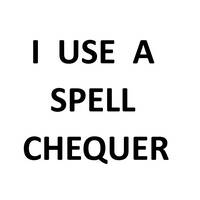 Not Yet Replaced By AI
Not Yet Replaced By AIThis transcription item is now locked to you for editing. To release the lock either Save your changes or Cancel.
This lock will be automatically released after 60 minutes of inactivity.